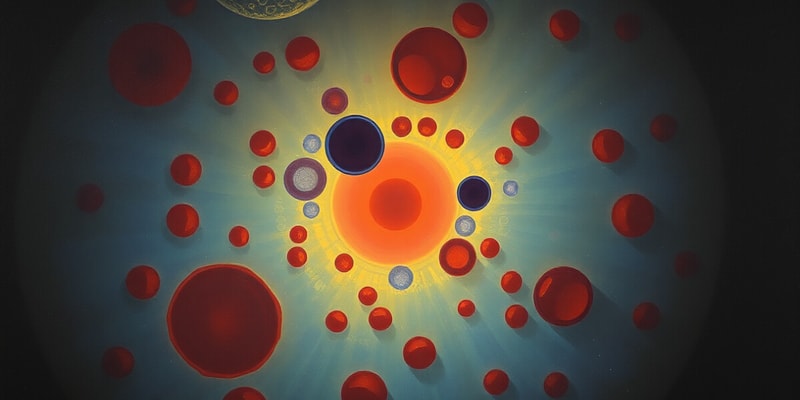Podcast Beta
Questions and Answers
What is the thickness of microtubules?
What are microtubules composed of?
How many protofilaments does a microtubule usually have?
Which end of the microtubule is exposed to a-tubulin?
Signup and view all the answers
What does each tubulin monomer bind?
Signup and view all the answers
What drives the polymerization and depolymerization of microtubules?
Signup and view all the answers
What is the role of y-tubulin in microtubules?
Signup and view all the answers
What type of subunits are a-tubulin and B-tubulin?
Signup and view all the answers
How does the length of microtubules change?
Signup and view all the answers
What gives the microtubule structure polarity?
Signup and view all the answers
What is the result of myosin head hydrolyzing ATP to ADP and inorganic phosphate?
Signup and view all the answers
What happens when the myosin head binds to actin?
Signup and view all the answers
What are kinesins and dyneins involved in during interphase?
Signup and view all the answers
What is responsible for the movement of cilia and flagella?
Signup and view all the answers
What is the function of molecular motors in muscle contraction?
Signup and view all the answers
What occurs when the myosin head is in a low-energy configuration?
Signup and view all the answers
What leads to the movement of the thin filament toward the center of the sarcomere?
Signup and view all the answers
What is the primary result of the hydrolysis of ATP to ADP and inorganic phosphate?
Signup and view all the answers
What is the role of kinesins and dyneins during cell division?
Signup and view all the answers
What is the function of dynein in cellular processes?
Signup and view all the answers
What is the role of GTP binding to α-tubulins in stabilizing microtubules?
Signup and view all the answers
What is the function of centrosomes in cell biology?
Signup and view all the answers
What is the main difference between cilia and flagella?
Signup and view all the answers
What is the primary function of molecular motors, such as kinesins and dyneins?
Signup and view all the answers
What are the steps involved in motor movement associated with microtubules?
Signup and view all the answers
What is the role of basal bodies in cell biology?
Signup and view all the answers
What determines the rate of microtubule polymerization?
Signup and view all the answers
What is the function of microtubule-organizing centers (MTOCs) in cell biology?
Signup and view all the answers
What is the primary function of centrosomes in cell division?
Signup and view all the answers
What is the consequence of concentrations of α-tubulin being below the critical concentration?
Signup and view all the answers
Study Notes
Microtubules, Centrosomes, and Molecular Motors in Cell Biology
- Microtubules exhibit dynamic instability with faster growth and shortening at the plus end, and slower growth and shortening at the minus end.
- GTP binding to α-tubulins stabilizes microtubules, protecting them from fast disassembly, while GDP-tubulin at the minus end is more prone to depolymerization.
- Microtubules can undergo rapid cycles of assembly and disassembly and treadmilling, where one end polymerizes while the other end disassembles.
- The rate of microtubule polymerization depends on the critical concentration of α-tubulin, with concentrations above leading to polymerization and below leading to depolymerization.
- Microtubule-organizing centers (MTOCs) play a central role in microtubule nucleation and organization, with centrosomes and basal bodies being key MTOCs.
- Centrosomes, containing centrioles and pericentriolar material, anchor the minus ends of microtubules in interphase and play a role in spindle formation during cell division.
- Basal bodies, formed from centrioles, are involved in the formation of flagella and cilia, containing nine triplets of microtubules and anchoring in the plasma membrane.
- Cilia and flagella, hair-like cell appendages, are formed by microtubules and surrounded by a membrane, with cilia being more numerous and shorter, while flagella are responsible for cell movement.
- Molecular motors, such as kinesins and dyneins, can change ATP energy into mechanical energy, bind to microtubules, and transport cell structures within the cell.
- There are different types of molecular motors associated with microtubules and microfilaments, such as kinesins and dyneins for microtubules and myosins for microfilaments, each moving in different directions and carrying different cargo.
- The motor movement consists of four steps: filament binding, conformational change, filament release, and conformational relaxation, allowing for the transport of cellular structures.
- Molecular motors associated with microtubules, such as kinesins and dyneins, move in different directions and carry different cargo, while myosins associated with microfilaments also transport cargo within the cell.
Studying That Suits You
Use AI to generate personalized quizzes and flashcards to suit your learning preferences.
Description
Test your knowledge of microtubules, centrosomes, and molecular motors in cell biology with this quiz. Explore dynamic instability, microtubule nucleation, MTOCs, and the functions of centrosomes and basal bodies. Learn about the role of molecular motors like kinesins and dyneins in cell structure transport.




